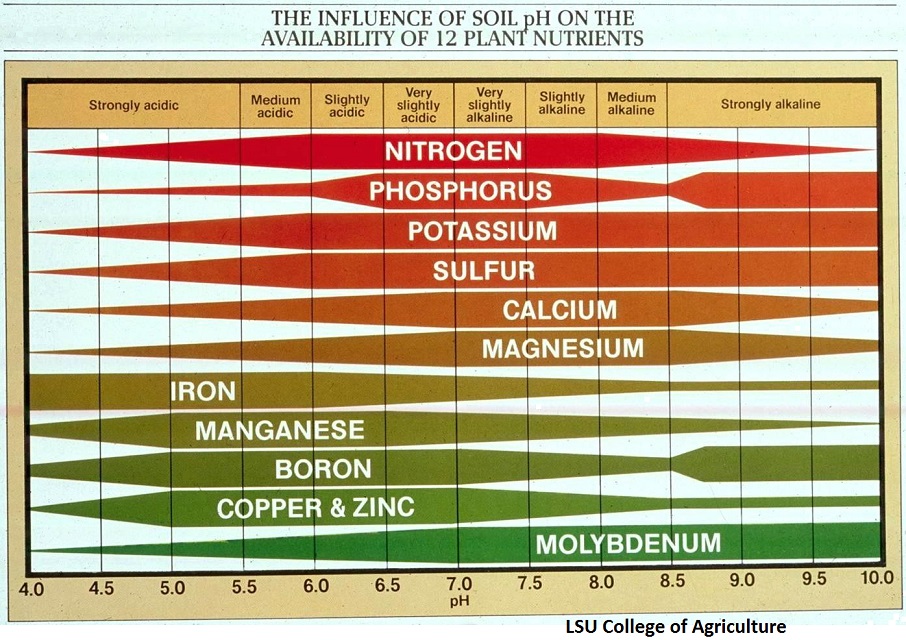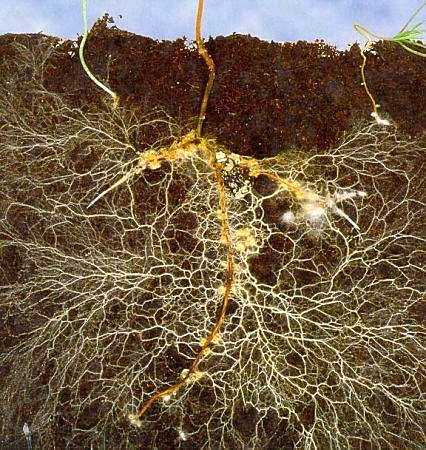
Plants need water, air, light, suitable temperature, and sixteen nutrients to grow. Plants get carbon, hydrogen and oxygen from air and water. The other thirteen nutrients come from the soil. Soil nutrients are divided into two groups according to the amounts needed by plants. The Macronutrients are nitrogen, phosphorus, potassium, calcium, magnesium, and sulfur. The Micronutrients, which are needed in only trace amounts, are iron, manganese, boron, zinc, copper, molybdenum and chlorine.
These nutrients are essential for plant growth. Plants will grow normally until they run short of one nutrient. Then growth is limited by the availability of that nutrient. Occasionally two or more nutrients will run short at the same time. If the nutrients are deficient, or too abundant, then plants will be discolored or deformed. Deficiency symptoms indicate which nutrient or nutrients are needed, although the symptoms vary from one plant to another. It is much better to supply additional nutrients before deficiency symptoms appear. A soil test or leaf analysis will tell which nutrients are low before growth is affected.
Nitrogen, N, stimulates leaf and stem growth. Nitrogen deficiency causes reduced growth and pale yellowish green leaves. The older leaves turn yellowish first since the nitrogen is readily moved from the old leaves to the new growth. If the soil is cold and wet, nitrogen in the soil is not as available to the plants. Excess nitrogen may cause potassium deficiency.
Phosphorus, P, is important in the germination and growth of seeds, the production of flowers and fruit, and the growth of roots. Phosphorus deficiency causes reduced growth and small leaves that drop early, starting with the oldest leaves. Leaf color is a dull, bluish green that becomes purplish or bronzy. Leaf edges often turn scorched brown. Excess phosphorus may cause potassium deficiency.
Potassium, K, promotes general vigor, disease resistance and sturdy growth. Potassium deficiency causes stunted growth with leaves close together. Starting with the older leaves, the leaf tips and edges turn scorched brown and leaf edges roll.
Calcium, Ca, is a major ingredient in cell walls and is important for root growth, especially root tips. Calcium deficiency causes poorly developed roots with weak tips. Leaves are distorted with hooked tips and curled margins that often turn brown.
Magnesium, Mg, is vital to chlorophyll production and is important in most enzyme reactions. Magnesium deficiency causes different symptoms in different plants, but commonly includes leaf yellowing with brilliant tints. Leaves may suddenly drop off without withering. Symptoms show first on older leaves.
An excessive amount of Potassium, K, Calcium, Ca or Magnesium, Mg, can interfere with the absorption of the other two. A general rule is to provide Potassium, Calcium and Magnesium in a 4:3:1 ratio. Excessive Sodium, Na, from fertilizer or water, especially softened water, can also interfere with Potassium, Calcium and Magnesium uptake.
Sulfur, S, is an ingredient in proteins and is necessary for chlorophyll formation. Sulfur deficiency causes slow growth with small round leaves that roll upward and are stiff and brittle. Leaves drop off and tip buds die.
Iron, Fe, is necessary for chlorophyll formation and for oxygen transfer. Iron deficiency causes leaf yellowing while leaf veins stay green. Younger leaves are affected first because iron does not move from old leaves to new leaves. Excess lime may cause iron deficiency.
Manganese, Mn, is a catalyst for many enzymes and is important for chlorophyll formation. Manganese deficiency causes different symptoms in different plants, but commonly causes leaves to turn yellow while veins stay green. White or gray specks may appear on leaves. Older leaves are affected first. Excess manganese may cause iron deficiency and may cause symptoms similar to manganese deficiency.
Boron, B, is necessary for the movement of sugars, for reproduction, and for water intake by cells. It also tends to keep calcium in a soluble form. Boron deficiency causes distorted and dead growing tips, hollow stems and deformed fruit. Leaves are often scorched and curled and sometimes mottled, discolored and thickened. Young leaves are affected first. Excess boron may cause scorched leaf edges similar to potassium or magnesium deficiencies.
Zinc, Zn, is necessary for the production of proteins and affects plant size and maturity. Zinc deficiency causes leaf yellowing between the veins, usually with purple or dead spots starting with the older leaves. Leaves are close together, small and deformed. Fruiting is reduced. Excess zinc may cause iron deficiency.
Copper, Cu, is necessary for the production of proteins and is important for reproduction. Copper deficiencies causes bluish green leaves which may wither or fail to unfold. Younger leaf tips may be yellow at the edge. Growing tips may form rosettes. Excess copper may cause iron deficiency.
Molybdenum, Mo, is essential to nitrate enzymes and for the formation of root nodules in beans and peas. Molybdenum deficiencies cause yellow mottling and dead spots on the leaves. In some plants, the growing tips are distorted or killed.
Chlorine, Cl, may affect carbohydrate metabolism and photosynthesis. Chlorine deficiencies may cause stubby roots and wilting. Excess chlorine may cause leaf edges to scorch similar to potassium deficiency. Chlorine in treated water might be two to four times higher than plants need.
Some nutrients may be plentiful in the soil but deficient in plants because they are bound up in chemical compounds that make them unavailable to plants. Soil pH can make a big difference in nutrient availability. Soil pH is a measure of hydrogen ion concentration. It is tested either with a chemical pH test, or by a pH meter. 7.0 is neutral. 4.0 is very acid. 10.0 is very alkaline. High rainfall and high organic matter produces acid soil. Low rainfall and high lime or sodium produces alkaline soils.
The majority of plant nutrients are most available at slightly acid to neutral. The availability of phosphorus drops off rapidly as pH drops below 6.5, but iron is more available as soil is more acid. Soil can be made less acid by adding lime (calcium carbonate), or more acid by adding sulfur or aluminum sulfate. Lime will raise the soil pH in a few weeks or several months depending on how finely ground the lime particles are. Sulfur takes about a year to lower soil pH since bacteria are required to complete the process.

Nutrient availability is greatly enhanced if mycorrhizae are present in the soil. Mycorrhizae are beneficial fungi, the white netting growing out of the brown roots in the picture below. The network of mycorrhizae can absorb four or five times as much water and nutrients as is absorbed directly through roots. They seem to be much better than roots at extracting phosphorus from acid soil.

Most plants in most soils will grow better if additional nutrients are provided by fertilizing. A soil test will give a complete and accurate measure of the nutrients in the soil. A general recommendation is that all soils need more nitrogen. Shallow rooted plants, such as grass and flowers, need more phosphorus and potassium. Acid loving plants, such as rhododendrons, azaleas, camellias, junipers and pin oaks, often need more iron. Sometimes sandy soils need micronutrients, but rarely clay soils. Certain micronutrients may be deficient in certain parts of the country. Boron is sometimes deficient in the Pacific Northwest.
Many fertilizers are available to supply additional nutrients. Some fertilizers only supply one nutrient. Many supply N, P and K only. A few fertilizers include all of the macronutrients and micronutrients. The label on the package will tell which nutrients are included as well as the sources of the nutrients. The nutrients are identical whether they come from organic or synthetic sources, but the source will affect how fast the nutrients are available to plants. Ammonia sulfate and water soluble fertilizers release most of their nitrogen in a few days and may burn plants if too much is applied at one time. Blood meal releases its nitrogen over a period of months. Organic fertilizers and specially treated synthetic fertilizers release slowly so they last longer and won't burn. Since phosphorus is bound up and made unavailable in a few weeks in acid soil, bone meal is much better since it releases its phosphorus over a period of several months. Deeper rooting trees and shrubs can be fertilized once a year, but shallow rooted plants, such as grass and flowers, will need regular fertilizing throughout the growing season.
Water can move nitrogen several inches in the soil. Nitrogen that is applied in the fall may be carried too deep into the soil by winter rains. February or March is the best time to feed trees and shrubs. Phosphorus and potassium hardly move in the soil. To get them down to tree roots, either punch a hole in the soil with a bar and pour in a tablespoon of granular fertilizer or use a root feeder to inject water soluble fertilizer 12" deep every two feet in rings from the trunk to twice the length of the branches. The feeder roots are found throughout the area under and around a tree, not just at the drip line.
Herbs for the Kitchen and Landscape
House Plants
Improving Soil
Lacebug Control
No One Wins an Argument